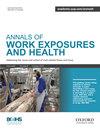43 空气传播的蛋白质--食品行业职业接触的新特异性标志物?
IF 1.8
4区 医学
Q3 PUBLIC, ENVIRONMENTAL & OCCUPATIONAL HEALTH
引用次数: 0
摘要
食品行业的工人会接触到多种物质,这些物质可能会引起免疫反应,导致鼻炎和哮喘等职业病。由于这些工作环境中的成分种类繁多,对职业接触进行监管具有挑战性。重力测量是这些接触的职业接触限值(OEL)的基础。然而,重量测量法并不考虑粉尘中存在的化合物,因此也会包括糖粉等无害物质。如果对接触粉尘的程度和含量缺乏了解,就很难在食品行业为职业健康服务机构和企业开展预防工作。因此,需要为食品行业制定更精确的 OEL 值,以更好地描述接触情况,并进行循证风险评估。本项目将提供有关各类食品生产中可吸入粉尘量与空气中可吸入蛋白质总量之间关系的新知识。此外,这项研究还将提供有关粉尘量、蛋白质总量、粉尘的总炎症潜能值和特定过敏原之间关系的新知识。研究结果将使企业更容易确定应在哪些方面优先实施减少接触的措施。从长远来看,研究结果可能有助于用更好、更具体的 OEL 标准取代食品工业中目前未明确规定的重力暴露限值。本文章由计算机程序翻译,如有差异,请以英文原文为准。
43 Airborne proteins - A new specific marker for occupational exposure in the food industry?
Workers in the food industry are exposed to a wide range of substances that might elicit immunological reactions leading to occupational diseases such as rhinitis and asthma. It’s challenging to regulate the occupational exposure due to the wide variety of components present in these work environments. Gravimetric measurements have served as the foundation for the occupational exposure limits (OEL) for these exposures. However, gravimetric measurements do not consider which compounds that are present in the dust and will thus also include harmless substances such as sugar dust. It is difficult to carry out preventive work in the food industry for occupational health services and enterprises when there is a lack of knowledge about both the degree and content of dust exposure. A more precise OEL for the food industry to better describe exposure and enable evidence-based risk assessments is therefore needed. This project will provide new knowledge about the relationship between the amount of inhalable dust and the amount of total inhalable protein present in air in connection with various types of food production. In addition, the study will provide new knowledge about the relationship between the amount of dust, total protein, total inflammatory potential of the dust and specific allergens where possible. The study’s findings will make it easier for companies to prioritize where exposure-reducing measures should be implemented. In the long term, the findings may help to replace the current unspecified gravimetric exposure limits in the food industry with better and more specific OELs.
求助全文
通过发布文献求助,成功后即可免费获取论文全文。
去求助
来源期刊

Annals Of Work Exposures and Health
Medicine-Public Health, Environmental and Occupational Health
CiteScore
4.60
自引率
19.20%
发文量
79
期刊介绍:
About the Journal
Annals of Work Exposures and Health is dedicated to presenting advances in exposure science supporting the recognition, quantification, and control of exposures at work, and epidemiological studies on their effects on human health and well-being. A key question we apply to submission is, "Is this paper going to help readers better understand, quantify, and control conditions at work that adversely or positively affect health and well-being?"
We are interested in high quality scientific research addressing:
the quantification of work exposures, including chemical, biological, physical, biomechanical, and psychosocial, and the elements of work organization giving rise to such exposures;
the relationship between these exposures and the acute and chronic health consequences for those exposed and their families and communities;
populations at special risk of work-related exposures including women, under-represented minorities, immigrants, and other vulnerable groups such as temporary, contingent and informal sector workers;
the effectiveness of interventions addressing exposure and risk including production technologies, work process engineering, and personal protective systems;
policies and management approaches to reduce risk and improve health and well-being among workers, their families or communities;
methodologies and mechanisms that underlie the quantification and/or control of exposure and risk.
There is heavy pressure on space in the journal, and the above interests mean that we do not usually publish papers that simply report local conditions without generalizable results. We are also unlikely to publish reports on human health and well-being without information on the work exposure characteristics giving rise to the effects. We particularly welcome contributions from scientists based in, or addressing conditions in, developing economies that fall within the above scope.
 求助内容:
求助内容: 应助结果提醒方式:
应助结果提醒方式:


